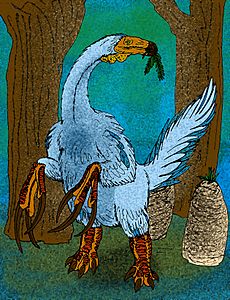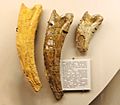Therizinosaurus facts for kids
Quick facts for kids TherizinosaurusTemporal range: Upper Cretaceous
|
|
|---|---|
 |
|
| Conservation status | |
|
Fossil
|
|
| Scientific classification | |
| Kingdom: | |
| Phylum: | |
| Class: | |
| Superorder: | |
| Order: | |
| Suborder: | |
| Infraorder: | |
| Family: | |
| Genus: |
Therizinosaurus
|
| Species: |
T. cheloniformis
|
| Binomial name | |
| Therizinosaurus cheloniformis Maleev, 1954
|
|
Therizinosaurus was a huge herbivorous theropod dinosaur from the end of the Cretaceous period.
New, well-preserved finds such as Alxasaurus in 1993 and Beipiaosaurus in 1996 provided details about the bird-like pelvis, feet and skulls of primitive members. This helped confirm they belonged to the same group of theropod dinosaurs as Therizinosaurus and that therizinosaurs were, more specifically, advanced, herbivorous maniraptoran theropods.
Their fossils were first found in the late 1940s in Asia. They were named in 1954 after more bones were found. It was a thought to be a carnivore and herbivore; it had very long claws - they were about 3 ft long.
Paleobiology
The feeding habits of Therizinosaurus are unknown, since no skull material has ever been found that could indicate its diet. However, like other therizinosaurs, it was probably primarily herbivorous.
There are multiple possible functions that could have been served by the claws of Therizinosaurus, such as defense against predators (e.g. the contemporary Tarbosaurus) and in intraspecific fighting, such as fighting for territory or for mating, or to pull leafy tree branches towards its mouth. The claws may have served all these functions.
Images for kids
-
Cretaceous fossil localities of Mongolia; Therizinosaurus fossils have been collected from the Altan Uul, Hermiin Tsav, and Nemegt localities at the area A (Nemegt Formation)
-
Mounted skeleton of Alxasaurus at the Royal Tyrrell Museum. Alxasaurus helped to resolve important aspects about the affinities of the long-enigmatic therizinosaurs
-
Feather impressions from the holotype of Beipiaosaurus
-
Lateral view of the unguals in specimens MPC-D 100/15, 100/16 and 100/17. Therizinosaurus may have used its claws for grasping foliage
-
Life restoration of a Therizinosaurus pair along with a small group of Tylocephale, and Adasaurus
See also
 In Spanish: Therizinosaurus para niños
In Spanish: Therizinosaurus para niños















